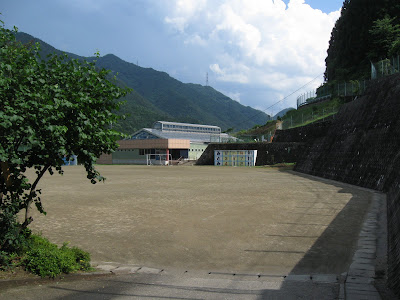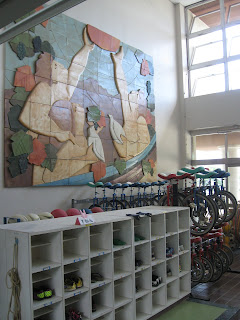Last Friday was the Autumnal Equinox which is a national holiday in Japan. I decided to use the three day weekend to do a bit of traveling, so I went to a peninsula just to the south of me called Izu.

Izu was its own province before the Meiji era, but for the past hundred plus years it has been part of Shizuoka Prefecture. It is mostly famous for having nice scenery and a lot of natural beauty, and being the setting of "The Izu Dancer," a short story I read in college by Kawabata Yasunari (the first Japanese author to win the Nobel for Literature).
I spent most of Friday and Sunday traveling, stopping in Ito and Atami. I had planned on taking a bus to Shuzenji which I had been assured was possible by an empolyee of the bus company, but it turned out that bus only ran once a day, so that was a bit unfortunate.
I spent all of Saturday in Shimoda, which is a port town on the southern tip of the peninsula. It served as the inspection port for ships during the Edo Period (1603-1868) but is better known for its role in the opening of Japan to the West.
In 1853, Commodore Perry sailed into what's now Tokyo Bay with a small fleet of steam ships and demanded that Japan open up ports at which U.S. Whaling ships could resupply themselves. He returned a few months later in '54 and the Shogunate directed him to Shimoda, where he signed the treaty opening that port to American vessels and established a consulate at a different temple in the town. A couple years later, Townsend Harris arrived and set up the embassy in Shimoda where he stayed until he was able to bargin for a better location for his embassy, which he was granted about a year and a half after he arrived.
So, here are a few highlights of the trip.
 |
| A street in Ito. There wasn't much to do here, but it was a nice city. |
 |
| A model of Perry's ship outside the station in Shimoda, with a small frowning samurai statue next to it for no reason. |
 |
| The temple where the treaty opening Japan to America was signed. |
 |
| This is the temple where the treaty opening Japan to Russia was signed, which I did not know about until I got to Shimoda. I knew that the great powers of the day (England, Russia, France, etc.) were all given similar treaties to the one with the U.S. but I didn't know that while the Russians were in port at Shimoda, a tsunami destroyed their ship. They built a new ship in a nearby town with the help of local Japanese workmen who became the shipbuilders of Japan's modern navy, which defeated Russia in a naval battle in the Russo-Japanese war fifty years later. Funny how that worked out. |
 |
| A view of the Pacific to the south. |
 |
| Monument to Commodore Matthew Perry |
 |
| The bay, with a sightseeing boat made up to look like one of the "black ships." |
 |
| Gyokusenji, the temple which served as the first American consulate. A monument to Townsend Harris has a quote from his journal the day they raised the U.S. flag commenting on how their presence was the beginning of the end for the Shogun and complaining about the size of the mosquitoes. |
|
 |
| The graves of five American sailors from Perry's expedition at the same temple. |
 |
| Again, graves of sailors at Gyokusenji. This time, Russian sailors who died during the Tsunami. Apparently, this temple was also where the Russians were quartered during their stay, a year before Harris set up shop there. |
 |
| A monument to the gent on the right, Shimooka Renjou. A local man who took an interest in photography and learned everything he could about it from Harris's Dutch interpreter. He went on to be the father of Japanese photography. |
 |
| Monument to commemorate the great friendship born the day Perry threatened to bombard the coast if they didn't deliver his letter to the Emperor featuring quotes from Perry, "I've come here as a peacemaker" and Harris "My mission is a friendly one in every respect." |
 |
| And a random monument next to the previous one commemorating Jimmy Carter's Presidential visit to Shimoda on the 125th anniversary of the signing of the treaty. |
Well, that's all for today. The trip was a good time, and a nice rest. As of tomorrow evening, all of my schools will have had their Undoukai, so I should be back to a full schedule next week and I may have less to write about, but I'll try to come up with something or other. Until next time.
 Izu was its own province before the Meiji era, but for the past hundred plus years it has been part of Shizuoka Prefecture. It is mostly famous for having nice scenery and a lot of natural beauty, and being the setting of "The Izu Dancer," a short story I read in college by Kawabata Yasunari (the first Japanese author to win the Nobel for Literature).
Izu was its own province before the Meiji era, but for the past hundred plus years it has been part of Shizuoka Prefecture. It is mostly famous for having nice scenery and a lot of natural beauty, and being the setting of "The Izu Dancer," a short story I read in college by Kawabata Yasunari (the first Japanese author to win the Nobel for Literature). 











































